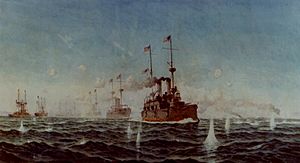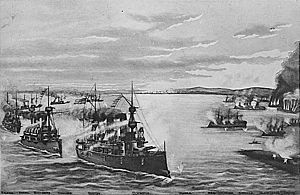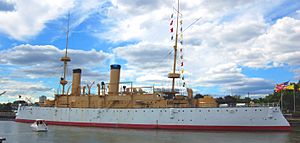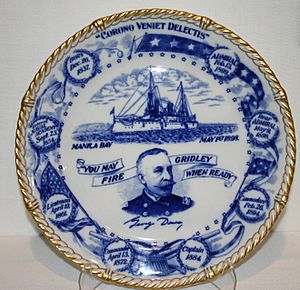Battle of Manila Bay facts for kids
Quick facts for kids Battle of Manila Bay |
|||||||
|---|---|---|---|---|---|---|---|
| Part of the Spanish–American War | |||||||
 Battle of Manila Bay, 1 May 1898, Fred S. Cozzens |
|||||||
|
|||||||
| Belligerents | |||||||
| Commanders and leaders | |||||||
| Strength | |||||||
| 4 protected cruisers 2 gunboats 1 revenue cutter 2 transport ships |
2 protected cruisers 5 unprotected cruisers 5 gunboats 1 transport ship |
||||||
| Casualties and losses | |||||||
| 1 dead of illness 9 wounded 1 protected cruiser damaged |
77 killed 271 wounded 2 protected cruisers scuttled 5 unprotected cruisers sunk 1 transport ship sunk |
||||||
The Battle of Manila Bay, also called the Battle of Cavite, happened on May 1, 1898. It was a big naval battle during the Spanish–American War. The American Asiatic Squadron, led by Commodore George Dewey, fought and destroyed the Spanish Pacific Squadron, led by Rear admiral Patricio Montojo.
This battle took place in Manila Bay in the Philippines. It was the first major fight of the Spanish–American War. It was a very important naval battle that ended Spain's control over the Philippines.
Tensions between Spain and the United States grew because of Spain's actions in the Cuban War of Independence. Many Americans were upset by reports of harsh treatment of the Cuban people. In January 1898, the USS Maine was sent to protect American interests in Cuba. Less than a month later, the ship exploded in Havana harbor, killing 261 sailors. This made Americans very angry and helped start the war.
When the war began, Americans knew they needed to defeat the Spanish fleet in the Philippines. Commodore Dewey, a veteran of the American Civil War, led the U.S. Asiatic Squadron. On May 1, his squadron sailed into Manila Bay to fight the Spanish. The Spanish knew they were outmatched, but they fought bravely. The battle was not very close. The American ships had better guns and skilled sailors. The entire Spanish fleet was sunk, and the Americans had very few casualties. Montojo ordered his two main ships to be sunk on purpose so the Americans couldn't capture them. This battle is still seen as one of the most important naval battles in American history.
Contents
Why the Battle Happened
Rising Tensions Before the War
Before the battle, people on the West Coast of the United States worried about a Spanish attack. The U.S. Navy had only a few warships there, like the cruiser USS Olympia. But the Olympia was much stronger than the Spanish ships in the Philippines.
Spain's Weak Fleet
Admiral Montojo, a Spanish naval officer, was sent to the Philippines. His fleet had many old ships. Efforts to make his fleet stronger didn't help much. Spain's leaders knew they probably couldn't win the war. They saw fighting as a way to save face.
The Spanish fleet in Manila had too few sailors, and they were not well trained. Reinforcements from Spain were weak. Two poorly armored scout cruisers were sent. At the same time, a stronger Spanish squadron was moved from Manila to the Caribbean.
Montojo's Difficult Choices
Admiral Montojo first wanted to fight at Subic Bay, northwest of Manila Bay. But he found out that the planned mines and coastal defenses there were missing. Also, his ship, the Castilla, started leaking.
Montojo then decided to place his ships in shallow water in Manila Bay. This was outside the range of Spanish coastal artillery. He wanted to protect Manila from being bombed. He also hoped his sailors could swim to safety if their ships were sunk. The harbor had six shore batteries and three forts, but their guns were not very effective during the battle. Only Fort San Antonio Abad had guns that could reach the American fleet, but Dewey stayed out of their range.
The Spanish Ships
The Spanish squadron had seven ships:
- Reina Cristina (Montojo's main ship)
- Castilla
- Don Juan de Austria
- Don Antonio de Ulloa
- Isla de Luzon
- Isla de Cuba
- The gunboat Marques del Duero
These Spanish ships were not as good as the American ones. The Castilla couldn't move on its own and had to be pulled by another ship. On April 25, the Spanish squadron left Manila Bay for Subic. They planned to set up defenses there. But on April 28, they learned that the American squadron was coming to Subic. The Spanish commanders decided to move back to Manila Bay. They arrived at midnight on April 29.
The Battle Begins
Dewey's Surprise Attack
At 7 p.m. on April 30, Montojo heard that Dewey's ships were seen in Subic Bay. Foreigners thought Manila Bay was too dangerous to sail at night. So, Montojo expected an attack the next morning.
However, Oscar F. Williams, the U.S. Consul in Manila, had given Dewey good information. He told Dewey about the weak Spanish defenses and fleet. Using this information, Dewey, on the Olympia, led his squadron into Manila Bay at midnight on April 30.
Entering Manila Bay
As they entered, two Spanish mines exploded, but they were too deep to hit any ships. Ships usually used the north channel, which was mined. But Dewey used the unmined south channel between El Fraile and Caballo Islands. The El Fraile battery fired a few shots, but they were too far away.
At 5:15 a.m. on May 1, the American squadron was near Manila. The Cavite battery fired warning shots. The shore batteries and Spanish fleet then opened fire. But all their shells fell short because the American fleet was still out of range.
"You May Fire When Ready, Gridley"
At 5:41 a.m., Dewey gave his famous order: "You may fire when ready, Gridley". The Olympia's captain was told to start attacking the Spanish ships.
The U.S. squadron sailed in a line in front of the Spanish ships and forts. They fired their port (left) guns. Then they turned around and sailed back, firing their starboard (right) guns. They did this five times, getting closer each time, from 5,000 yards to 2,000 yards. The Spanish forces were ready, but they had much weaker guns. Eight Spanish ships, land batteries, and forts fired back for two and a half hours. Five other small Spanish ships did not join the fight.
Spanish Resistance Fails
Montojo knew his situation was hopeless. He ordered his ships to try to ram the American ships if possible. He then moved the Cristina forward to charge. Many American ships fired at her, and she was badly damaged. More than 200 of her 400 crew members were hurt or killed, including Montojo. Only two men could still fire her guns. The ship managed to get back to shore, and Montojo ordered it to be sunk.
The Castilla had guns only on its left side. A cable was shot away, making her turn and show her unarmed right side. Her captain ordered her to be sunk and abandoned. The Ulloa was hit below the water, killing her captain and hurting half her crew. The Luzon had three guns out of action. The Duero lost an engine and had only one gun left.
A Short Break
At 7:45 a.m., Dewey ordered his ships to stop fighting and pull back. He told his crews it was time for breakfast to keep their spirits up. An observer on the Olympia noted that some Spanish ships were on fire, but so was one American ship. These fires were put out without much damage. It seemed no Spanish ship was seriously hurt yet. Montojo used this break to move his remaining ships into Bacoor Bay. He ordered them to fight as long as they could.
American Victory
During the break, a meeting on the Olympia showed little damage to American ships and no one killed. It turned out that the message about ammunition was misunderstood. They had only *used* 15 rounds per gun, not had only 15 rounds *left*.
Reports came in that the Cristina and Castilla were exploding and on fire. At 10:40 a.m., the battle started again. The Spanish offered little resistance. Montojo ordered his remaining ships to be sunk. He also told his men to take the important parts of their guns ashore so the Americans couldn't use them.
The Olympia, Baltimore, and Boston then fired on the Sangley Point battery, putting it out of action. They then sank the Ulloa. The Concord fired on the transport ship Mindanao, whose crew quickly left the ship. The Petrel fired at the government offices near the arsenal. A white flag was raised over the building, and all firing stopped. The Spanish flag was taken down at 12:40 p.m.
Dewey won the battle with only seven men slightly wounded and one death from a heart attack. The Spanish had 77 killed and 271 wounded.
What Happened Next
After the Battle
Spain tried to send another naval force, called Camara's Flying Relief Column, to attack Dewey. But this effort failed. The naval war in the Philippines then became a series of small attacks by Spanish torpedo boats. While the Spanish hit American ships several times, no Americans died directly from Spanish gunfire.
On May 2, Dewey sent Marines ashore at Cavite. They finished destroying the Spanish fleet and batteries. They also guarded the Spanish hospitals. The forts offered little resistance. The Olympia fired at the Cavite arsenal, blowing up its magazine. This ended all firing from the Spanish batteries.
Dewey sent a message to Washington. He said he controlled Manila Bay, but he needed 5,000 more men to capture Manila itself.
Honoring the Victory
Admiral Dewey's Legacy
To honor George Dewey's leadership, a special medal called the Dewey Medal was given to the officers and sailors under his command. Dewey was later promoted to the special rank of Admiral of the Navy.
Because he was so popular, Dewey briefly ran for president in 1900. But he later stopped and supported William McKinley, who was already president and won. In the same year, Dewey became President of the General Board of the United States Navy. He played a big role in making the U.S. Navy stronger until he died in 1917.
Places like Dewey Square in Boston and Dewey Beach, Delaware, are named after Admiral Dewey. In Union Square, San Francisco, there is a 97-foot (30 m) tall monument celebrating Admiral Dewey's victory at the Battle of Manila Bay.
Ships in the Battle
The American ships were generally larger and more powerful.
- USS Olympia: This was Dewey's main ship. It was a protected cruiser with four 8-inch guns and ten 5-inch guns. It could go 20 knots. Today, it is a museum ship in Philadelphia, Pennsylvania.
- USS Baltimore: A protected cruiser with four 8-inch guns and six 6-inch guns. Top speed 20 knots.
- USS Raleigh: A protected cruiser with one 6-inch and ten 5-inch guns. Top speed 19 knots.
- USS Boston: A protected cruiser with two 8-inch and six 6-inch guns. Top speed 13 knots.
- USS Concord: A gunboat with six 6-inch guns. Top speed 17 knots.
- USS Petrel: A gunboat with four 6-inch guns. Top speed 12 knots.
Even with their better guns, the American ships didn't hit every shot. They fired 5,859 shells. Only 145 of these hit the seven Spanish ships that were fighting.
The Spanish ships were older and less powerful.
- Reina Cristina: Montojo's main ship. An unprotected cruiser with six 6.4-inch guns. It was the fastest Spanish ship at 16 knots.
- Castilla: An unprotected cruiser with four 5.9-inch and two 4.7-inch guns. Its 8-inch guns had been removed for shore defenses. It was used as a floating battery because it couldn't move.
- Don Antonio de Ulloa: An unprotected cruiser with two 4.7-inch guns. It was being repaired and couldn't move. Many of its guns were removed for shore defenses.
- Don Juan de Austria: An unprotected cruiser with four 4.7-inch guns. Top speed 13 knots.
- Isla de Cuba: A protected cruiser with six 4.7-inch guns. Top speed 14 knots.
- Isla de Luzon: A protected cruiser with six 4.7-inch guns. Top speed 14 knots.
- Marques del Duero: A gunboat with one 6.4-inch and two 4.7-inch guns. Top speed 10 knots.
The Spanish ships had 19 torpedo tubes, but no working torpedoes.
Shore Defenses
The Spanish also had several forts and batteries on land:
- Fort San Antonio Abad: In Manila. Only its 9.4-inch guns could reach Dewey's ships.
- Fort San Felipe: A small castle in Cavite City.
- Cavite Fort: A fortified naval base next to Fort San Felipe.
- Corregidor battery, Caballo battery, and El Fraile battery: At the entrance to Manila Bay. El Fraile fired a few shots but was quickly silenced.
- Cañacao battery: Had one 4.7-inch gun but did not fire.
- Sangley Point battery: Had three old cannons and two 5.9-inch guns (which did fire).
- Malate battery: In Malate. Did not fire.
Some guns from Montojo's fleet were used to strengthen these land batteries.
Images for kids
-
Admiral Cámara's Spanish Fleet anchored in the Suez Canal, 1898. This fleet did not fight in the war.
The United States Navy ships:
The destroyed Spanish ships after the battle:
See also
 In Spanish: Batalla de Cavite para niños
In Spanish: Batalla de Cavite para niños
- Battle of Manila (disambiguation)
- Battles of the Spanish–American War
- Philippine–American War
- List of naval battles



















